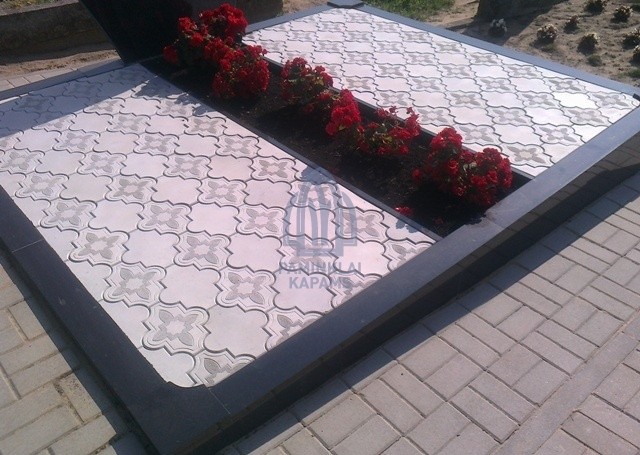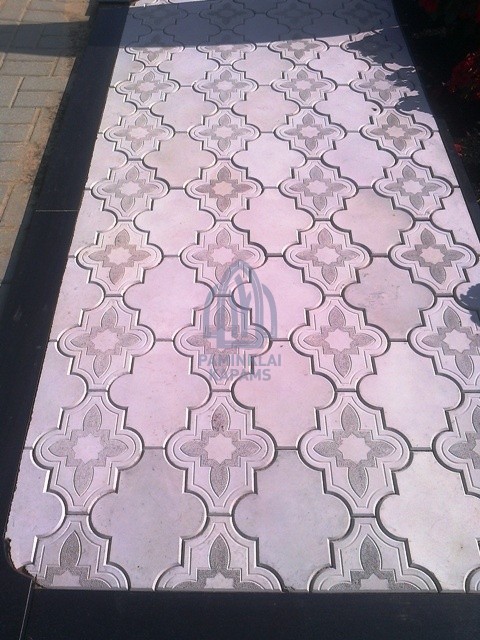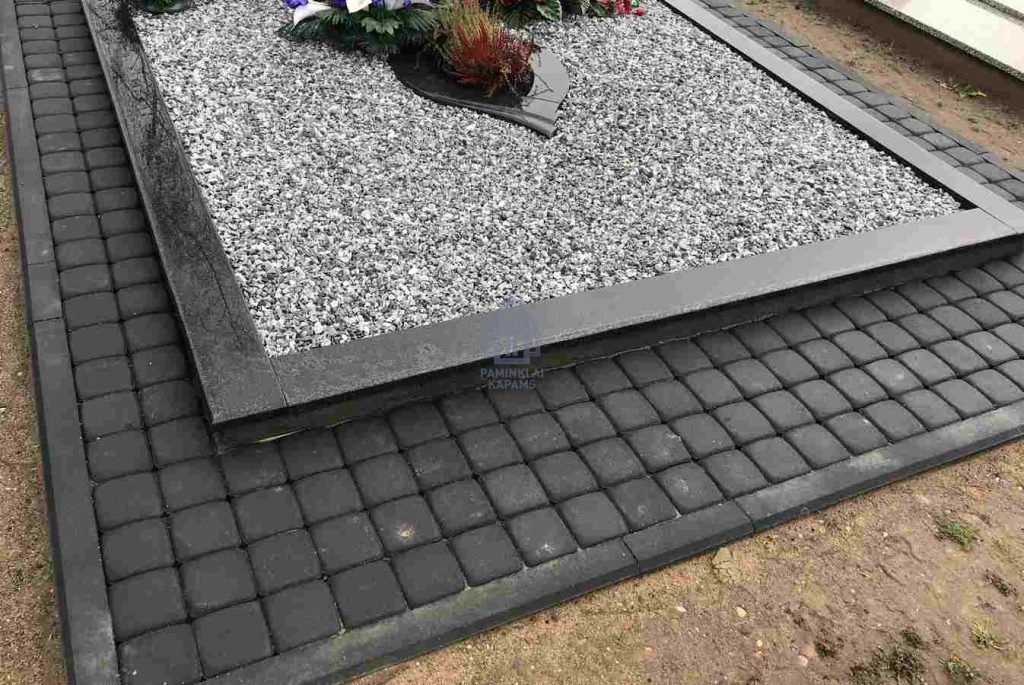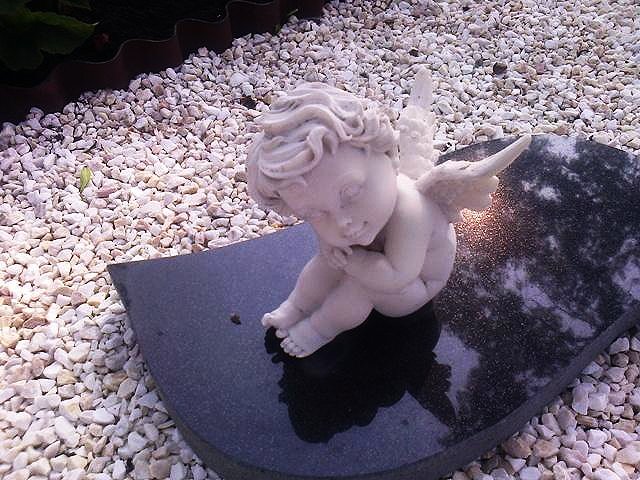Shades of monuments and selection of pavers
Tombs covered by brick plates
A Few Practical Tips for Choosing Paving Stones for Cemetery Pathways
Cemetery pathways should be practical, durable (resistant to environmental factors), and aesthetically pleasing. When selecting paving stones for pathways between graves or on the grave itself, it is important to consider several key factors:
Protecting the Grave’s Foundation – Properly laid paving stones protect the grave’s foundation from the long-term effects of water on concrete.
Easy Repairs – If some paving stones sink or the border stones shift, there is no need to remove the entire paved area—only the affected section needs to be fixed.
Resistance to Various Weather Conditions – Paving stones should be resistant to winter frost, moisture, sunlight, and temperature fluctuations. High-quality paving should be visually attractive for decades.
Load Resistance – The load-bearing capacity of paving stones (when used for cemetery pathways or grave coverings) is not a critical factor, as the path will mostly be used by pedestrians and will not experience traffic from vehicles or heavy machinery. Therefore, investing in thicker paving stones is unnecessary – unless the grave is located near an internal cemetery road where vehicles might occasionally pass. In such cases, using thicker paving stones would be advisable.
Surface Structure of Paving Stones – Cemetery drainage systems are not always well-maintained, leading to frequent damp conditions. Additionally, snow tends to remain longer in cemeteries during winter. Therefore, it is advisable to avoid paving stones with smooth surfaces, as they can become hazardous in autumn, winter, or rainy weather. To prevent traumas, opt for non-slip or textured paving stones.
Colour and Design of Paving Stones – It is essential to consider the colour of the granite used in the gravestones and grave coverings. The gravestone, granite slabs, and paving stones should complement each other visually. The most common choices are grey (concrete), black (clinker or granite), or reddish-coloured paving stones, as they match well with granite elements on the grave (gravestone, granite slabs, and borders) without being too bright.
Maintenance of Paving Stones – Paving stones require more maintenance than gravestones or granite slabs. To prevent moss and dirt buildup, it is better to choose clinker or granite paving stones, which are easier to clean and maintain.
Which Type of Paving Stones to Choose?
Concrete Paving Stones – These are the most common choice due to their affordability and durability. However, they are not highly resistant to weather conditions; after 5-7 years, they tend to darken and lose their aesthetic appeal. Regular maintenance and cleaning every few years are necessary. The most popular size for concrete paving stones is 0.10 x 0.20 m, and they come in various shapes, including square, “pillow-shaped”, rectangular, and “clover-shaped”.
Clinker Paving Stones – Made from natural clay, these paving stones stand out for their durability, strength, and unique appearance. They are available in a wide range of colours but are significantly more expensive than concrete paving stones. Clinker paving stones do not absorb dirt and are easy to clean.
Granite Paving Stones – Considered the most luxurious option due to their elegant look and long lifespan. Granite paving stones are highly resistant to environmental factors but come at a higher price and require more complex installation. Maintenance difficulty depends on the texture of the granite surface – rougher surfaces may require more care.
Important Considerations When Choosing Granite Paving Stones
- Granite Type and Quality Characteristics
o Dense and low-porosity granite is resistant to moisture and frost.
o The most common choices are black granite (Swedish, which appears grey when unpolished), pink (Aurora), and grey (Kuru Grey). Gravestones and granite slabs are often made from the same type of granite, but their surfaces are polished. - Surface Finishing is Crucial
The most popular option is split-surface granite paving stones, typically measuring 0.10 x 0.10 x 0.10 m. These are non-slip but require additional maintenance over time due to their rough texture.
Flamed granite surfaces are also non-slip and are an excellent choice for cemetery pathways. If choosing flamed granite paving stones, it is recommended that the monument also has a flamed surface for a consistent look. Polished granite surfaces are undoubtedly beautiful but can become very slippery when wet or snowy, posing a safety risk. - Granite Paving Stone Sizes
The most common sizes for granite paving stones are 10×10 cm, 10×20 cm, or 15×15 cm. Smaller paving stones may look more aesthetically pleasing, but their installation can take more time.
Common Mistakes When Installing Granite Paving Stones
- Improper Base Preparation
Proper base preparation is essential. It must be well-compacted and correctly prepared (including soil levelling and the installation of a gravel and sand base). If this step is skipped, no matter how high-quality the paving stones are, they may sink or shift over time. - Incorrect Paving Jointing and Lack of Slope
Improper gaps between the paving stones can cause problems. If the gaps are too wide, dirt can accumulate, leading to faster growth of grass and moss. It is also crucial for the paved surface to have at least a slight slope to allow water to drain naturally during heavy rain. - Choosing the Right Filler Material for Joints
The most commonly used fillers are quartz sand or finely crushed stones, which help prevent grass and moss growth between the paving stones. - Poor-Quality Installation
Inexperienced workers may not follow essential paving principles, resulting in an uneven surface and inconsistent gaps between the stones. This can negatively impact the overall appearance and durability of the installation.
Paving stones are an excellent choice for arranging and enhancing cemetery pathways. However, it is important to select high-quality, long-lasting paving stones and ensure they are installed by experienced professionals who provide at least a few years of warranty for their work.





